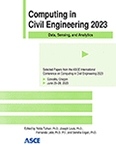Leveraging Artificial Intelligence for Enabling Personalized Activity-Based Workplaces
Publication: Computing in Civil Engineering 2023
ABSTRACT
Thanks to emerging technologies and increased computational power, a new wave of smart buildings is gaining attraction with a specific focus on the personal experience of individual occupants. Real-time monitoring and estimation of human states are key to achieving individual satisfaction. This paper proposes a framework to predict and track the real-time state of each individual and assist with the decision-making of room assignment and environment control. The core idea of the framework is to distinguish individuals by an idea of the personal database named human digital ID (DID). Two case studies are given to demonstrate the adoption of the framework. They show how different indoor well-being such as thermal comfort and work engagement can be incorporated into the framework. The results show improvement in the occupants’ well-being after adopting the framework. The framework is scalable in every aspect and can serve as a fundamental concept for future smart buildings.
Get full access to this article
View all available purchase options and get full access to this chapter.
REFERENCES
Appel-Meulenbroek, R., Groenen, P., and Janssen, I. (2011). “An end‐user’s perspective on activity‐based office concepts.” Journal of Corporate Real Estate, 13(2), 122–135.
Arundell, L., Sudholz, B., Teychenne, M., Salmon, J., Hayward, B., Healy, G. N., and Timperio, A. (2018). “The Impact of Activity Based Working (ABW) on Workplace Activity, Eating Behaviours, Productivity, and Satisfaction.” International Journal of Environmental Research and Public Health, 15(5).
ASHRAE. (2017). Standard 55-2017, Thermal Environmental Conditions for Human Occupancy, Atlanta USA.
Deng, M., Fu, B., and Menassa, C. “Room match: Achieving thermal comfort through smart space allocation and environmental control in buildings.” Proc., Proceedings of the 2021 Winter Simulation Conference.
Deng, M., Menassa, C. C., and Kamat, V. R. (2021). “From BIM to digital twins: a systematic review of the evolution of intelligent building representations in the AEC-FM industry.” Journal of Information Technology in Construction (ITcon), 26(5), 58–83.
Deng, M., Wang, X., Li, D., and Menassa, C. C. (2022). “Digital ID framework for human-centric monitoring and control of smart buildings.” Building Simulation.
Deng, M., Wang, X., and Menassa, C. C. (2021). “Measurement and prediction of work engagement under different indoor lighting conditions using physiological sensing.” Building and Environment, 203, 108098.
Földváry Ličina, V., et al. (2018). “Development of the ASHRAE Global Thermal Comfort Database II.” Building and Environment, 142, 502–512.
Frontczak, M., and Wargocki, P. (2011). “Literature survey on how different factors influence human comfort in indoor environments.” Building and Environment, 46(4), 922–937.
Gan, V. J. L., Deng, M., Tan, Y., Chen, W., and Cheng, J. C. P. (2019). “BIM-based framework to analyze the effect of natural ventilation on thermal comfort and energy performance in buildings.” Energy Procedia, 158, 3319–3324.
Huizenga, C., Abbaszadeh, S., Zagreus, L., and Arens, E. A. (2006). “Air quality and thermal comfort in office buildings: results of a large indoor environmental quality survey.” Proceeding of Healthy Buildings, 393–397.
Ioannou, A., Itard, L., and Agarwal, T. (2018). “In-situ real time measurements of thermal comfort and comparison with the adaptive comfort theory in Dutch residential dwellings.” Energy and Buildings, 170, 229–241.
Jahncke, H., and Hallman, D. M. (2020). “Objective measures of cognitive performance in activity based workplaces and traditional office types.” Journal of Environmental Psychology, 72, 101503.
Karmann, C., Schiavon, S., and Arens, E. (2018). Percentage of commercial buildings showing at least 80% occupant satisfied with their thermal comfort.
Kim, J., Schiavon, S., and Brager, G. (2018). “Personal comfort models – A new paradigm in thermal comfort for occupant-centric environmental control.” Building and Environment, 132, 114–124.
Li, D., Menassa, C. C., and Kamat, V. R. (2017). “Personalized human comfort in indoor building environments under diverse conditioning modes.” Building and Environment, 126, 304–317.
Stone, P. J., and Luchetti, R. (1985). “Your office is where you are.” 63(2), 102–117.
Tang, S., Shelden, D. R., Eastman, C. M., Pishdad-Bozorgi, P., and Gao, X. (2019). “A review of building information modeling (BIM) and the internet of things (IoT) devices integration: Present status and future trends.” Automation in Construction, 101, 127–139.
Information & Authors
Information
Published In
History
Published online: Jan 25, 2024
ASCE Technical Topics:
- Artificial intelligence and machine learning
- Buildings
- Business management
- Case studies
- Computer programming
- Computing in civil engineering
- Databases
- Decision making
- Energy engineering
- Energy sources (by type)
- Engineering fundamentals
- Human and behavioral factors
- Hydro power
- Information Technology (IT)
- Methodology (by type)
- Personnel management
- Practice and Profession
- Renewable energy
- Research methods (by type)
- Smart buildings
- Structural engineering
- Structures (by type)
Authors
Metrics & Citations
Metrics
Citations
Download citation
If you have the appropriate software installed, you can download article citation data to the citation manager of your choice. Simply select your manager software from the list below and click Download.
